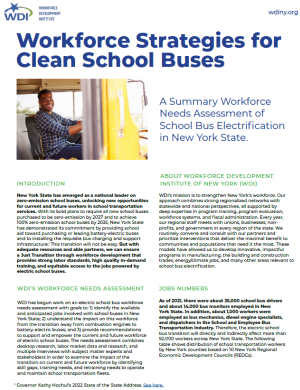
Workforce Strategies for Clean School Buses
New York State has emerged as a national leader on zero-emission school buses, unlocking new opportunities for current and future workers in school transportation services. With its bold plans to require all new school bus purchases to be zero- emission by 2027 and to achieve 100% zero-emission school buses by 2035, New York State has demonstrated its commitment by providing school aid toward purchasing or leasing electric buses and to installing the requisite bus charging and support infrastructure. School districts, school transportation contractors, and their affiliated labor unions will be most impacted by the electrification of New York’s school buses. Because of the complexity of this transition, the WDI has worked closely with its partners in the labor movement, government, education, manufacturing, and school districts to ensure a just transition through workforce development that provides strong labor standards, high quality in-demand training, and equitable access to the jobs powered by electric school buses.
WDI conducted a workforce needs assessment of school bus electrification to understand how it will impact the workforce that manufactures, operates, and maintains school buses. Using the lessons from early adopters in New York as well as in other states, we have identified opportunities and challenges for school districts, transportation contractors, and affiliated labor unions as they transition fleets. The research has highlighted a need for proactive training on three fundamental areas:
- Zero-emission bus familiarization: Training for drivers and technicians on the fundamentals of zero- emission vehicles, including component identification, differences between different technologies (battery electric, fuel cells, hybrid, etc.), operation of these technologies, energy storage systems, diagnostics, and maintenance.
- High-voltage awareness and safety training: Bus mechanics trained in conventional operating systems need specialized training with knowledge, skills, and safety practices specific to the use of high voltage equipment.
- Electric school bus charging training: Training to understand charging options, battery management systems and charger-to-bus communication, including orientation to existing and future charging technologies, charger maintenance and safety considerations, and up-front planning needed for electric bus facilities.
Read the full report here.